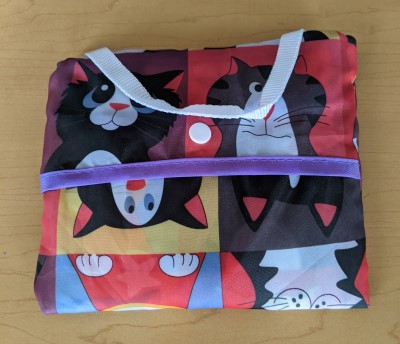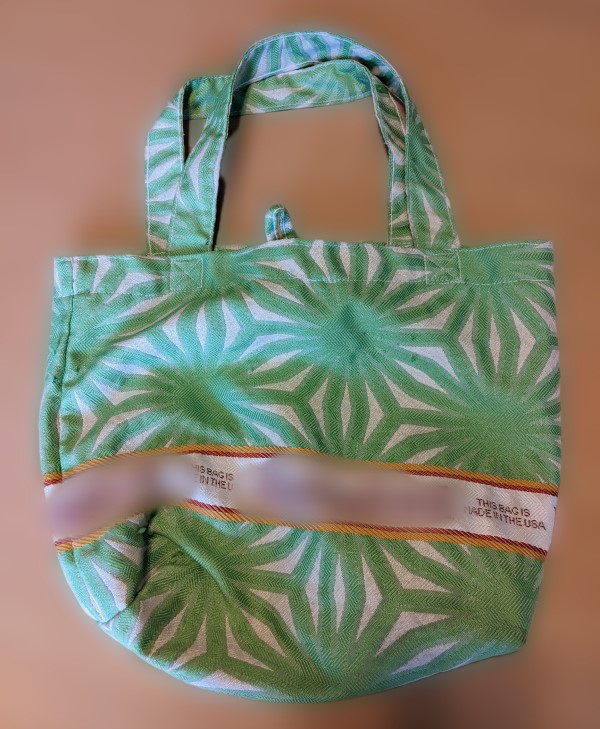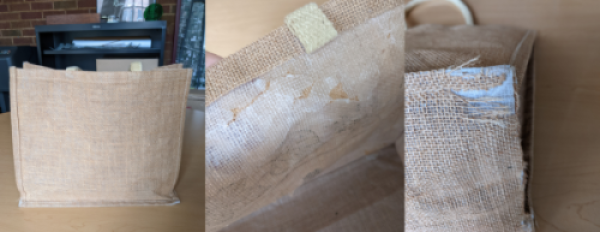Single use shopping bags are usually made out of plastic film or paper. Despite their greener image, paper bags require more energy and water than plastic bags to manufacture and transport. However, on the disposal side, paper bags are highly recyclable in curbside bins, and plain brown varieties from grocery stores can even be
composted at home. Plastic film bags can be recycled at store drop-offs, usually to be used in composite lumber. While it is better to use recycled plastic film than new material for composite lumber, this should still properly be considered down-cycling, because in 20-30 years when the lumber is worn out, it can't be recycled again.
In reality, many people don't make the effort to take plastic bags for recycling. Plastic bags that are landfilled may take hundreds of years to decompose. Plastic shopping bags also easily become litter. Unfortunately, some people litter on purpose, but it is also very easy for wind to blow loose plastic bags out of garages and vehicles, including garbage collection trucks. In its
2020 litter study, Keep America Beautiful found 307 million plastic bags along America's roads and waterways. If they get into water, plastic bags become a hazard to wildlife and water quality.
Reusable Shopping Bags - Which Bag is Best?
Reusable shopping bags can be made out of many different types of material. Any reusable bag takes more energy and water to manufacture and transport than one single use bag.
Reusable bags are only eco-friendly if you actually reuse them at least 10 times! Similar to single-use bags, reusable bags are made out of either plastic or plant fiber and they can differ quite dramatically in terms of functionality and sustainability. We did a series of reusable bag reviews in Kane County Connects - you can read in series part one,
part two and
part three. Our scores for all bags appear in the graphic below.
| Sustainability (productions) | Affordability | Durability | Washability | Storage (disposal) | Sustainability | OVERALL |
|---|
| Single-use plastic |
3 of 5 |
5 of 5 |
1 of 5 |
1 of 5 |
4 of 5 |
2 of 5 |
2.5 of 5 |
| Single-use paper |
2 of 5 |
5 of 5 |
1 of 5 |
1 of 5 |
4 of 5 |
4 of 5 |
3 of 5 |
| Thick plastic film (reusable) |
2 of 5 |
4 of 5 |
3 of 5 |
2 of 5 |
4 of 5 |
2 of 5 |
3 of 5 |
| Waffle/non-woven polypropylene |
2 of 5 |
4 of 5 |
3.5 of 5 |
3 of 5 |
2 of 5 |
1 of 5 |
2.5 of 5 |
| Polyester & nylon - TOP CHOICE! |
2 of 5 |
3.5 of 5 |
4 of 5 |
4 of 5 |
4.5 of 5 |
3 of 5 |
3.5 of 5 |
| Coarse-woven polypropylene |
2 of 5 |
4 of 5 |
5 of 5 |
3 of 5 |
2 of 5 |
1 of 5 |
3 of 5 |
| Cotton canvas - TOP CHOICE! |
1 of 5 |
3 of 5 |
5 of 5 |
4 of 5 |
3 of 5 |
4 of 5 |
3.5 of 5 |
| Lined jute/burlap |
1 of 5 |
4 of 5 |
2 of 5 |
2 of 5 |
2 of 5 |
2 of 5 |
2 of 5 |
Plastic Material Bags
The County Recycling Coordinator recommends woven polyester and nylon bags as having the best mix of sustainability, storability, washability and durability. If you find a bag that can be scrunched into a small carry pouch, that's a polyester or nylon bag.

This nylon tote folds nearly flat for easy storage (Photo: C. Ryan)
This type of bag needs to be reused about 30 times to break even on environmental impact compared to single-use plastic bags, but a bag used for weekly grocery shopping will reach this point in about seven months. Synthetic fabric can be made of recycled drink bottles, can be recycled as textile at end of life, and come in a whole range of colors and designs. They are usually machine washable. The only real "con" is that they do tend to be a bit more expensive, usually costing a few dollars per bag - or up into the $10-20 range per bag at the higher end for a designer look or brand.

This bag was made from polyester fabric in the USA. After 13 years of use,
it has a few loose and pulled threads but no major tears (Photo: C. Ryan)
The runner-up for plastic reusable bags, again, in your Recycling Coordinator's experience, is woven polypropylene. If you look at the inside of these bags, you should be able to see the weave of the material. They score about the same as polyester/nylon bags for durability. They are highly reusable, but not as recyclable at the end of life. They are not as easy to machine wash but are easy to surface wash by hand. They are a lot more bulky than other types of reusable bags. They are usually pretty cheap - a dollar or two per bag.

Woven polypropylene with obvious cross-hatch weave (left) is durable and strong. Non-woven polypropylene
is soft and has a waffle-like pattern (right), but may not hold up as well over time (Photos: Canva Pro)
Although non-woven reusable bags, made of either polypropylene or PET, are cheap (often given away as promo items) and ubiquitous, they can be prone to tearing especially at the handles, and especially if overfilled, so they might not make it to the 30 uses mark they need to be more eco-friendly than single-use bags. They are also less easy to wash than other types.
Plant Fiber Bags
The good old cotton canvas tote is an awesome tool, but it should really be viewed as a "use it for life" item and not a throw-away or collectable. Cotton production requires a lot of land and water. Conventional cotton uses agrichemicals, and organic cotton uses even more land and more water because organic cotton varieties produce less per acre than conventional types. The message here isn't not to buy things made of cotton but to understand that cotton bags have to be used hundreds - even possibly thousands of times to break, even from a resource use perspective. If you use the same cotton tote for weekly groceries, it might take 10 or 20 years to pay an environmental dividend. That said, there's no reason a sturdy canvas bag can't last that long or longer, if well cared for. Canvas bags are probably in the same price range as polyester bags, and can be recycled as textile at the end of life. They are biodegradable and don't contribute microplastics to the environment.

This jute bag might look fine from a distance, but after a couple of years of use, the plastic lining
is flaking off and the burlap fraying around the bottom corners (Photos: C. Ryan)
Another fairly common type of natural fiber bag is jute/burlap, usually with a thin plastic lining and canvas or nylon handles. Your County Recycling Coordinator recommends plain canvas over this type of bag due to concerns about durability. Jute bags also have to be used hundreds of times to break even on sustainability, but the plastic lining tends to start flaking apart after a year or so of use (hello microplastics!), and the jute frays along the bottom of the bag making long-term reuse unlikely. They are also difficult to wash.
Should You Make the Switch?
If you're thinking of switching from single-use to reusable bags there are a couple of things to ask yourself:
Do you reuse single use bags for other purposes? If so, and you stopped getting single use bags at the store, would you need to buy more bags?
If you currently use plastic shopping bags for pet waste, diaper containment, lining small trash cans, etc. and would start buying bags for those purposes if you did not have shopping bags to reuse, it might not make sense to switch 100% to reusable. It might make sense to get single-use bags for items like meat and loose produce, and use reusable bags for dry goods and non-food items.
Another question is whether keeping your bags clean and handy for when you go shopping is actually compatible with your lifestyle. It isn't too hard to do, but if you suspect you just won't or can't do it, it's better to stick to (and recycle) single-use bags than it is to buy a bunch of reusable bags that never get used.
Reusable Bag Hygiene
Studies have found that reusable shopping bags are often breeding grounds for bacteria, including pathogens like e. coli that can make people sick. However, bag owners in the same studies confessed that they generally never wash their bags and store them in non-temperature controlled environments like cars and garages, which is a recipe for bacterial growth.
The bottom line is that bags should be washed on a regular basis. Studies show that a good wash eliminates pretty much all bacteria on bags. A reusable bag used to carry raw meat should be washed after each use for that purpose. Fabric bags are machine washable, and some can be put in the drier on low heat, but air-drying will probably extend the life of the bags. Stiffer woven bags are easy to wipe clean with a damp, soapy cloth or anti-bacterial wipe.
If you can avoid it, don't store your bags in your car or in the garage, especially in the summer. Bacteria thrives in hot and humid conditions. Fabric bags, especially nylon and polyester, can be scrunched down pretty small to reduce storage space.
Other Reusable Bag Tips
- Keep a cheap carabiner or other fastener with your bags so that you can clip them to shopping carts and save on cart space
- Get really comfortable telling cashiers and baggers "I'd like to use my own bags, please!" and/or "I don't need a bag, thanks!" Single-use bags are still the norm at most stores.
- Reusable bags aren't just for grocery stores! Get in the habit of taking them on all your errands.
- Forget your bag? It happens! Can you carry the item(s) you're buying without a bag? You aren't obligated to carry things in a bag, and the walk between store and car then car to home is often pretty short.